Papers by Muhammad Abd-el-Maguid
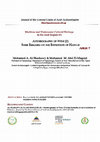
Maritime and underwater Cultural Heritage in the Arab Region 9/2, 2024
The current study undertakes a closer examination of a segment of the nautical endeavors chronicl... more The current study undertakes a closer examination of a segment of the nautical endeavors chronicled in Weni's autobiography, which pertains to an expedition involving the construction of a barge with specific characteristics in terms of type, wood, and dimensions for the transportation of an offering table from Hatnub to Saqqara within a determined period. Despite the apparent simplicity of the vocabulary used in this inscription, it poses several challenges due to adopting the literal meanings, thereby impacting the translation and comprehension of the inscription. The key to deciphering this inscription takes two primary steps: Firstly, delineating the meanings of terms related to boatbuilding in the inscription, such as Sc and Spt, and understanding their precise and contextual significance; secondly, comparing these verbs with others employed for similar purposes elsewhere in Weni’s autobiography. This approach aims to validate the durations for the barge construction and navigation and discern the true significance of the seventeen-day timeframe and other pertinent nautical aspects. Undoubtedly, the integration of studies in Egyptian archaeology and nautical archaeology promises to shed light on these inquiries.
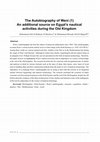
Abgadiyat 2024, Issue No. 18, 2024
Weni's autobiography has been the subject of numerous publications since 1864. 1 This autobiograp... more Weni's autobiography has been the subject of numerous publications since 1864. 1 This autobiography recounts Weni's various actions and his service to three kings of the Sixth Dynasty (ca. 2345-2181 BCE). 2 Among these works are various nautical activities, whether in the Nile or in the Mediterranean Sea during the reigns of Pepi I and Merenre. Although he listed some details, Egyptologists did not analyze them at an adequate level. Perhaps because they are not specialized in the field of nautical archaeology. Therefore, this paper focuses on highlighting Weni's nautical activities and its importance as a source of knowledge at the end of the Old Kingdom. The research describes the five missions with navigational parts. It studies and analyzes in detail its various elements such as the types of ships, their names, sizes, types of wood used in building ships and their construction methods from the point of view of nautical archaeology. The importance of re-studying Weni's autobiography lies in trying to deal with this activity in an integrated manner between Egyptology and nautical archaeology. The research concluded the existence of major economic activities and great projects in the Sixth Dynasty and the end of the Old Kingdom, despite the old beliefs about the weakness of the State in that period. It also clarifies and interprets some of the ambiguities of the text by subjecting it to the science of nautical archeology.
لتراث الثقافي الساحلي والمغمور بالمياه واقع الأبحاث واشكال التدبير والتثمين - تجارب من المغرب والوطن العربي, 2024
Over the past 25 years, Egypt has made significant strides in managing its underwater cultural he... more Over the past 25 years, Egypt has made significant strides in managing its underwater cultural heritage. This article explores the country's journey from scientific, administrative, technical, and academic perspectives, highlighting key achievements and ongoing challenges.

Quaternary Science Reviews
While the exact technical processes employed in the construction of the pyramids are still a subj... more While the exact technical processes employed in the construction of the pyramids are still a subject of ongoing debate, it is widely recognized that the Giza Plateau served as a hub where various trades converged with the common objective of building the necropolis. Of particular importance was the development of a local and sustainable food supply for the thousands of laborers involved in this monumental undertaking. Here, we explore the long-term behavioural mechanisms that led human societies to gradually colonize the Nile swamps at Giza. They developed herding and farming, paving the way for greater human exploitation of the area during the Dynastic Egypt. We show that transhumance tribes, originally from the Eastern Sahara, settled along the Giza Plateau 5200 years ago, primarily engaging in herding and, more sporadically, agriculture. Giza was transformed into a pastoral landscape, with the development of large swaths of the floodplain, providing societies with permanent access to livestock produce (e.g. proteins, milk, meat and wool). Our palaeoecological data reveal that the initial complex societies at Giza were deeply rooted in transhumance, pastoralism and animal husbandry. These activities played a fundamental role in establishing the foundations of a robust and sustainable food system, while also serving as a crucial logistical support for the subsequent construction of the monumental structures that celebrated the grandeur of pharaonic Egypt.
L'influence de l'espace de navigation nilotique et lagunaire sur la construction navale e... more L'influence de l'espace de navigation nilotique et lagunaire sur la construction navale en Egypte ancienne Mohamed M. Abd El-Maguid (Departement Central des Antiquites Sous-Marines, Egyptian Ministry of Antiquities - Center for Maritime Archaeology and Underwater Cultural Heritage, Alexandria University) Enregistrement audio: [cite
International Journal of Nautical Archaeology, 2010
... Super-Sized Egyptian Ships. Cheryl Ward 1 ,; Chiara Zazzaro 2 ,; Mohamed Abd El-Maguid 3. Art... more ... Super-Sized Egyptian Ships. Cheryl Ward 1 ,; Chiara Zazzaro 2 ,; Mohamed Abd El-Maguid 3. Article first published online: 3 AUG 2010. DOI: 10.1111/j.1095-9270.2010.00289.x. © 2010 The Authors. Journal Compilation © 2010 The Nautical Archaeology Society. Issue. ...
Journal of Maritime Archaeology, 2012
After many years of individual attempts to explore the underwater cultural heritage (UCH) of Egyp... more After many years of individual attempts to explore the underwater cultural heritage (UCH) of Egypt, the Supreme Council for Antiquities (SCA) established a department specializing in the field during the last decade of the twentieth century. The collaboration between this department and foreign missions led to the discoveries of a number of underwater sites and projects focusing on their protection, including mitigation work. This article presents the most important discoveries and displays the efforts of the SCA in the management of the UCH.
Méditerranée, 2005
Évolution géomorphologique de la façade maritime d'Alexandrie (Égypte) au cours des six derniers ... more Évolution géomorphologique de la façade maritime d'Alexandrie (Égypte) au cours des six derniers millénaires Geomorphological evolution of Alexandria's maritime façade during the past 6000 years
Les dossiers d'archeologie, 2016
This article gives a glimpse on recent discoveries that took place in the various districts of th... more This article gives a glimpse on recent discoveries that took place in the various districts of the great Alexandria which stretches from Aboukir in the East to al-Amreya in the South and to al-Agami in the West.
Thanks to the implementation of a new monitoring system for lands’ constructions, around fifty sites explored by inspectors from the Antiquities Department of Alexandria and its surroundings between 2011 and 2013 have yielded archaeological remains. These discoveries

The proceedings of the international conference entitled La batellerie égyptienne, organised by t... more The proceedings of the international conference entitled La batellerie égyptienne, organised by the Centre d'Études Alexandrines (USR 3134, CNRS), present the characteristic features of Egyptian water transport, which should not be simply confused with Nilotic water transport. There is also the shipping of the large lakes in the north of the Delta as well as that of the complex network of communications that tie together the river, the lakes and the canals. In order to reveal both particular and enduring aspects, the examination is over the long term, from Pharaonic Egypt up to the modern era, and it calls upon archaeological, historical, philological, papyrological and ethnographic sources. Given such a time scale, only significant elements have been highlighted for their ability to stand as exemplars and to create connections between the different periods. Thus, the juxtaposition of the different sources is present here in all its novelty and variety, opening up numerous angles of research. This work has enjoyed the financial support of the Honor Frost Foundation. Les Actes du colloque international La batellerie égyptienne organisé par le Centre d'Études Alexandrines (USR 3134 du CNRS) mettent en évidence les caractéristiques propres de la batellerie égyptienne qui ne saurait totalement se confondre avec la batellerie nilotique. S'y ajoutent celle des grands lacs situés au nord du Delta ainsi que le réseau complexe des communications mettant en jeu le fleuve, les lacs et les canaux. Pour faire apparaître les particularités et les permanences, l'étude porte sur la longue durée, de l'Égypte pharaonique aux temps modernes, et fait appel aussi bien aux sources archéologiques, historiques, philologiques et papyrologiques qu'ethnographiques. Sur une telle durée, seuls des éclairages significatifs ont été privilégiés pour leur exemplarité et leur capacité à établir des passerelles entre les diverses époques. À cet égard, la confrontation entre les différentes sources apparaît ici dans toute son originalité et sa richesse, en ouvrant de nombreuses perspectives de recherche. Cet ouvrage a bénéficié du soutien financier de la Honor Frost Foundation.

Alexandria under the Mediterranean Archaeological studies in memory of Honor Frost, 2015
This book is dedicated to the memory of Honor Frost and features her archeological bibliography p... more This book is dedicated to the memory of Honor Frost and features her archeological bibliography plus a previously unpublished article on the relationship between Byblos and Egypt, one of her favourite themes. In addition to the excavation of two Punic warships at Marsala, Sicily, Honor Frost concentrated much of her research on marine anchors. Following a presentation by an oceanographic team from the University of Patras of the underwater context of Alexandria, its geomorphological formation and the dangers for navigators, the volume includes a catalogue of 100 anchors. These have been discovered along 15 km of coastline, between the area of the Eastern Harbour and Maamura, by three underwater archaeological missions, Egyptian, French and Greek. The finds bear witness to the strong concentration of maritime trade in the vicinity of this major Egyptian city. This work has enjoyed the financial support of the Honor Frost Foundation. Dédié à la mémoire de Honor Frost, cet ouvrage comprend sa bibliographie archéologique, puis un article inédit de sa main sur les liens entre Byblos et l'Égypte, l'un de ses thèmes de prédilection. Outre la fouille de deux bateaux de guerre puniques à Marsala (Sicile), Honor Frost a consacré une grande partie de ses recherches aux ancres marines. Après la présentation par une équipe d'océanographes de l'Université de Patras du paysage sous-marin d'Alexandrie, de sa formation géomorphologique et de ses dangers pour la navigation, le volume comprend un catalogue raisonné d'une centaine d'ancres découvertes depuis les abords du Port oriental jusqu'à Maamura, sur plus de 15 km de côte, par trois missions archéologiques sous-marines, égyptienne, française et grecque, témoignages de la forte concentration du commerce maritime aux abords de la mégapole égyptienne. Cet ouvrage a bénéficié du soutien financier de la Honor Frost Foundation.

Alexandria under the Mediterranean Archaeological studies in memory of Honor Frost, 2015
This book is dedicated to the memory of Honor Frost and features her archeological bibliography p... more This book is dedicated to the memory of Honor Frost and features her archeological bibliography plus a previously unpublished article on the relationship between Byblos and Egypt, one of her favourite themes. In addition to the excavation of two Punic warships at Marsala, Sicily, Honor Frost concentrated much of her research on marine anchors. Following a presentation by an oceanographic team from the University of Patras of the underwater context of Alexandria, its geomorphological formation and the dangers for navigators, the volume includes a catalogue of 100 anchors. These have been discovered along 15 km of coastline, between the area of the Eastern Harbour and Maamura, by three underwater archaeological missions, Egyptian, French and Greek. The finds bear witness to the strong concentration of maritime trade in the vicinity of this major Egyptian city. This work has enjoyed the financial support of the Honor Frost Foundation. Dédié à la mémoire de Honor Frost, cet ouvrage comprend sa bibliographie archéologique, puis un article inédit de sa main sur les liens entre Byblos et l'Égypte, l'un de ses thèmes de prédilection. Outre la fouille de deux bateaux de guerre puniques à Marsala (Sicile), Honor Frost a consacré une grande partie de ses recherches aux ancres marines. Après la présentation par une équipe d'océanographes de l'Université de Patras du paysage sous-marin d'Alexandrie, de sa formation géomorphologique et de ses dangers pour la navigation, le volume comprend un catalogue raisonné d'une centaine d'ancres découvertes depuis les abords du Port oriental jusqu'à Maamura, sur plus de 15 km de côte, par trois missions archéologiques sous-marines, égyptienne, française et grecque, témoignages de la forte concentration du commerce maritime aux abords de la mégapole égyptienne. Cet ouvrage a bénéficié du soutien financier de la Honor Frost Foundation.
Books by Muhammad Abd-el-Maguid
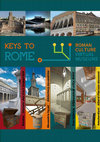
by Bruno Fanini, Daniele Ferdani, Niall O'hOisin, Paolo Vigliarolo, Leonardo Rescic, Sofia Pescarin, Alfonsina Pagano, Wim Hupperetz, Enzo d'Annibale, Muhammad Abd-el-Maguid, Daria Ruggeri, and B M On the 23 September 2014, after 2000 years from Augustus death, 13 countries have met in Rome, Am... more On the 23 September 2014, after 2000 years from Augustus death, 13 countries have met in Rome, Amsterdam, Alexandria and Sarajevo, for the opening of an extraordinary exhibition, “Keys to Rome”: an interactive journey to discover Roman Culture, starting from the city of Augustus and reaching the entire Roman Empire, through the visit to 4 fascinating venues, 4 museums with their archaeological collections, more than 10 different technologies supporting and enhancing this global experience.This is more than an exhibition on Roman archaeology. "Keys To Rome" is a unique international exhibition, that, for the first time is organized in parallel in four locations:Rome, in the wonderful setting of the Imperial Fora Museum (Museo dei Fori Imperiali);Alexandria, in the Antiquities Museums of the Bibliotheca Alexandrina; Amsterdam, in the recently renovated Allard Pierson Museum; and Sarajevo, in the newly restored City Hall (Vijecnica) and in the Sarajevo Museum.
Thesis Chapters by Muhammad Abd-el-Maguid
Several types of Egyptian boat models were discovered in the tombs of Kings, Queens and Nobles fr... more Several types of Egyptian boat models were discovered in the tombs of Kings, Queens and Nobles from the Old to the New Kingdoms throughout the ages. In 1913, American Egyptologist G.A.
Summer school, workshop by Muhammad Abd-el-Maguid
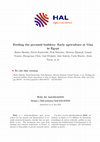
While the exact technical processes employed in the construction of the pyramids are still a
sub... more While the exact technical processes employed in the construction of the pyramids are still a
subject of ongoing debate, it is widely recognized that the Giza Plateau served as a hub where
various trades converged with the common objective of building the necropolis. Of particular
importance was the development of a local and sustainable food supply for the thousands of
laborers involved in this monumental undertaking. Here, we explore the long-term
behavioural mechanisms that led human societies to gradually colonize the Nile swamps at
Giza. They developed herding and farming, paving the way for greater human exploitation of
the area during the Dynastic Egypt. We show that transhumance tribes, originally from the
Eastern Sahara, settled along the Giza Plateau 5200 years ago, primarily engaging in herding
and, more sporadically, agriculture. Giza was transformed into a pastoral landscape, with the
development of large swaths of the floodplain, providing societies with permanent access to
livestock produce (e.g. proteins, milk, meat and wool). Our palaeoecological data reveal that
the initial complex societies at Giza were deeply rooted in transhumance, pastoralism and
animal husbandry. These activities played a fundamental role in establishing the foundations
of a robust and sustainable food system, while also serving as a crucial logistical support for
the subsequent construction of the monumental structures that celebrated the grandeur of
pharaonic Egypt.


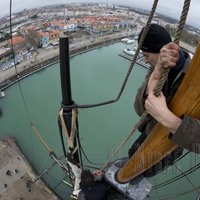








Uploads
Papers by Muhammad Abd-el-Maguid
Thanks to the implementation of a new monitoring system for lands’ constructions, around fifty sites explored by inspectors from the Antiquities Department of Alexandria and its surroundings between 2011 and 2013 have yielded archaeological remains. These discoveries
Books by Muhammad Abd-el-Maguid
Thesis Chapters by Muhammad Abd-el-Maguid
Summer school, workshop by Muhammad Abd-el-Maguid
subject of ongoing debate, it is widely recognized that the Giza Plateau served as a hub where
various trades converged with the common objective of building the necropolis. Of particular
importance was the development of a local and sustainable food supply for the thousands of
laborers involved in this monumental undertaking. Here, we explore the long-term
behavioural mechanisms that led human societies to gradually colonize the Nile swamps at
Giza. They developed herding and farming, paving the way for greater human exploitation of
the area during the Dynastic Egypt. We show that transhumance tribes, originally from the
Eastern Sahara, settled along the Giza Plateau 5200 years ago, primarily engaging in herding
and, more sporadically, agriculture. Giza was transformed into a pastoral landscape, with the
development of large swaths of the floodplain, providing societies with permanent access to
livestock produce (e.g. proteins, milk, meat and wool). Our palaeoecological data reveal that
the initial complex societies at Giza were deeply rooted in transhumance, pastoralism and
animal husbandry. These activities played a fundamental role in establishing the foundations
of a robust and sustainable food system, while also serving as a crucial logistical support for
the subsequent construction of the monumental structures that celebrated the grandeur of
pharaonic Egypt.
Thanks to the implementation of a new monitoring system for lands’ constructions, around fifty sites explored by inspectors from the Antiquities Department of Alexandria and its surroundings between 2011 and 2013 have yielded archaeological remains. These discoveries
subject of ongoing debate, it is widely recognized that the Giza Plateau served as a hub where
various trades converged with the common objective of building the necropolis. Of particular
importance was the development of a local and sustainable food supply for the thousands of
laborers involved in this monumental undertaking. Here, we explore the long-term
behavioural mechanisms that led human societies to gradually colonize the Nile swamps at
Giza. They developed herding and farming, paving the way for greater human exploitation of
the area during the Dynastic Egypt. We show that transhumance tribes, originally from the
Eastern Sahara, settled along the Giza Plateau 5200 years ago, primarily engaging in herding
and, more sporadically, agriculture. Giza was transformed into a pastoral landscape, with the
development of large swaths of the floodplain, providing societies with permanent access to
livestock produce (e.g. proteins, milk, meat and wool). Our palaeoecological data reveal that
the initial complex societies at Giza were deeply rooted in transhumance, pastoralism and
animal husbandry. These activities played a fundamental role in establishing the foundations
of a robust and sustainable food system, while also serving as a crucial logistical support for
the subsequent construction of the monumental structures that celebrated the grandeur of
pharaonic Egypt.